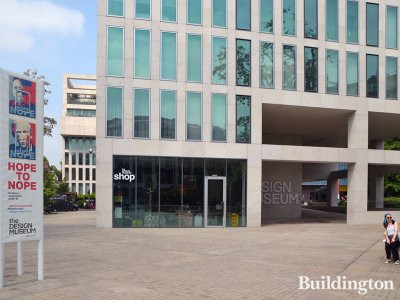Main contractor Mace has shared some of the highlights from working on the site of the new Design Museum and Hollandgreen apartment buildings.
Mace undertook a ‘cut and carve’ method to retain the roof and perimeter structure of the old building while demolishing the internal floors and extending the basement of the new building. This created a space three times the size, compared to its previous home at Shad Thames in south-east London.
An existing administration block was fully demolished for the new buildings and the works also included a redesign of the façades to allow natural light into the interior. Planning was secured from Royal Borough of Kensington and Chelsea with Historic England, the 20th Century Society and Friends of Holland Green to change the use of the building.
The new building includes a new two-storey basement, which extends beyond the footprint of the roof, enabling the creation of an additional temporary gallery space and a 200 seat auditorium.
The scheme required the 1,500 tonne roof to be suspended some 20 metres above ground level. This was supported by temporary works, which enabled the removal of the internal structural frame. Assessment of the existing roof identified that any movement of the key supports had to be controlled to within +/-5mm to avoid damage.
Some of the retained elements were strengthened to accommodate those expected movements and associated forces. These temporary ties consisted of four 100mm diameter high tensile bars that were pre-stressed to balance the thrust forces. To monitor the building movements, ensuring that these remained within the defined limits, the retained roof structure was continuously observed by using robotic survey equipment, affectionately known as Cyclops.
Once removal of the original internal structures had been completed, construction of the new permanent superstructure could then begin.
The client’s vision to build the world's foremost museum of contemporary design and architecture means design solutions were informed by environmental thermal analysis to ensure efficiency of energy, space and comfort – taking into account the flexible exhibition space and the optimisation of available daylight.
Mace’s COO Gareth Lewis, said: “Hollandgreen is an important project for the Royal Borough of Kensington and Chelsea and for London. With Mace’s help, Hollandgreen will again become one of the capital’s most iconic buildings, giving one of London’s unique cultural institutions a new lease of life, while providing high quality family accommodation in landscaped grounds that complement and integrate into the nearby Holland Park and the surrounding area.”
Reinier de Graaf, Partner, OMA, said: “In conceiving a future for one of London’s modernist buildings, we pay tribute to a period that continues to inform contemporary architecture. The Design Museum is flanked by the new residential blocks; like discreet servants, their restrained, orthogonal geometries pose a contrast to the dramatic hyperbolic lines of the historic exhibition hall’s roof.”
Simon Fraser, Partner, Allies and Morrison, said: “We relished the opportunity to contribute towards re-imagining a promising future for the Design Museum. The project has resulted in a striking assemblage of buildings within an enhanced urban park setting, which sensitively balances the needs of residents with the public benefit for future visitors to the new museum. The experience afforded us the opportunity to deepen our unique skills in the re-adaptation of Modernist landmarks, analogous to our work on the 2007 Royal Festival Hall transformation.”
Mark Wenlock, Group Development Director, Chelsfield, said: “The engineering challenges in maintaining the Grade II* Listed parabolic roof, whilst forming a double height new basement which extended beyond the ground floor foot print were immense. Arup and the main contractor, Mace, were involved in very complex engineering and temporary works solutions to make this possible. It’s a great testament to the expertise and dedication of Arup and Mace that the works proceeded without incident and the structure is now fit for many generations.”
Source: Mace

